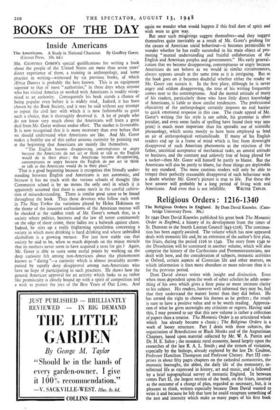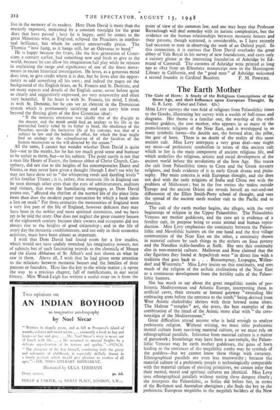Religious Orders : 1216-1340
IN 1940 Dom David Knowles published his great book The Monastic Order in England, a history of its development from the times of St. Dunstan to the fourth Lateran Council (943-1216). The continua- tion has been eagerly awaited. The volume which has now appeared deals with monastic life and, by an extension of the author's first plan, the friars, during the period 1216 to 5340. The story from 1340 to the Dissolution will be-continued in another volume, which will also comprise the history of the Carthusians and Premonstratensians, not dealt with here, and the consideration of subjects, monastic activities at Oxford, certain aspects of Cistercian life and other matters, on which information is then more abundant or more relevant than it is for the Previous period.
Dom David always writes with insight and distinction. Even when most dependent upon the work of other scholars he adds some- thing of his own which gives a finer poise or more intimate clarity to his subject. His readers, however well informed they may be, feel that they understand the matter better than they did before. He has earned the right to choose his themes as he prefers ; the result is sure to have a positive value and to be worth reading. Apprecia- tion of what he gives outweighs any criticism or regrets. Having said this, I may proceed to say that this new volume is rather a collection of papers than a treatise. The Monastic Order is an articulated whole which has already become a classic ; The Religious Orders is a work of looser structure. Pan I deals with three subjects, the organisation of Benedictines or Black Monks and of the Augustinian Chapters, based upon material collected by Mr. W. A. Pantin and Dr. H. E. Salter ; the monastic rural economy, based largely upon the researches of the late R. A. L. Smith • and the system of visitation, especially by the bishops, already explored by the late Dr. Coulton, Professor Hamilton Thompson and Professor Cheney. Part III com- prises in about fifty pages chapters on the cathedral monasteries, the monastic boroughs, the abbot, the daily life of the monastery, in- tellectual life as expressed in history, art and music, and is followed by a brief topographical survey of monastic England. In between comes Part II, the largest section of the book, on the friars, inserted as the outcome of a change of plan, regarded as necessary, init, it is pleasant to think, written especially because Dom David wanted to write it and because he felt that here he could recapture something of the zest and intensity which make so many pages of his first book
live in the memory of its readers. Here Dom David is more than the masterly exponent, restrained by a constant nostalgia for the great days that have passed ; here he is happy, until he comes to the great Mmorites who, in England, eclipsed the Preachers in intellec- tual brilliance, but whom he cannot unreservedly praise. The Thomist "bow hung, as it hangs still, for an Odysseus to bend." He is happy because the friars, like the first generation of Cister- cians a century earlier, had something new and fresh to give to the world, because he can allow his imagination full play while he rejoices in explaining the range and significance of one of the finest move- ments in recent historical investigation. He loves, as a generous mind does love, to give credit where it is due, but he loves also the oppor- tunity to add something all his own ; and indeed the pages on the background of the English friars, on St. Francis and St. Dominic, and on many aspects and details of the English scene, never before quite so clearly and suggestively expressed, are very noteworthy and often very beautiful. If his heart is with St. Francis, his mind, I think, is with St. Dominic, for he can see an element in the Dominican system which is permanently satisfying and can carry him even beyond the fleeting glory of the first Cistercian ideal :
"If the monastic obedience was ideally that of the disciple to the master, and the monk could find An analogy to his life in the patriarchal family ruled by its father as head, the obedience of the Preacher, outside the formative life of his convent, was that of a subject to law and the holders of office, for which the friar might find an analogy in the subordination of all the faculties of the human microcosm to the will directed by the reason."
All the same, I cannot but wonder whether Dom David is quite fair—not to the monks, for he has too much gcod sense and humour to be unfair to them, but—to his subject. The point surely is not that a man like Henry of Eastry, the famous abbot of Christ Church, Can- terbury, did not rise to the heights of his contemporaries Dante and Giotto, or may never have given a thought (though I don't see why he may not have done so) to "the whispering reeds and dazzling levels" of his familiar Thanet ; it is, rather, that monastic life in England can be seen through other eyes than the eyes of administrators, auditors and visitors, that even the humiliating mortgages, as Dom David points out, "affected the rhythm of the normal life of the place little more than does the modern paper transaction by which a bank takes a lien on stock." For three centuries the monasteries of England were a very live part of the life of England, however deficient they may have been in the nobler and more spiritual intensities, and we have yet to be told the story. One does not neglect the great country houses of the eighteenth century because their owners and occupants did not always rise to the heights of good citizenship ; and in the life of every day the monastic establishments, and not only in their economic activities, must have been almost as important.
I wish that Dom David had found room for a few studies, which would not have unduly stretched his imaginative powers, not of subjects but of such fascinating records as the chronicle of Meaux and the Gesta Abbatum of St. Alban's and just shown us what he saw in them. Above all, I wish that he had given some attention to the relations between monastic houses and the families of their patrons or founders. Here lies the key to the whole matter ; it opens the way to a precious chapter, full of ramifications, in our social history. Miss Wood-Leigh has written a useful essay on it from the point of view of the common law, and one may hope that Professor Barraclough will deal someday with its juristic complexities, but the evidence on the human relationships between monastic houses and their patrons, though scattered, is considerable, as I have recently had occasion to note in observing the work of an Oxford pupil. In this connection, it is curious that Dom David overlooks the great abbey of Vale Royal in his survey of new foundations, and casts only a cursory glance at the interesting foundation of Ashridge by Ed- mund of Cornwall. The customs of Ashridge were printed as long ago as 1812 from an Ellesmere manuscript now in the Huntington Library in California, and the "good men" of Ashridge welcomed a second founder in Cardinal Beaufort. F. M. POWICKE.



































 Previous page
Previous page